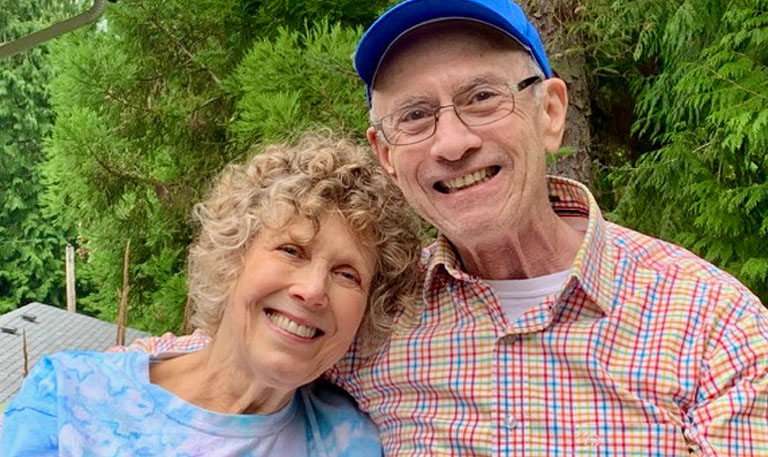We are standing in the middle of the small sloping parking lot adjacent to Good Burger. So okay, this is not the 50th Anniversary dinner we’d originally planned, it’s just the two of us, joyfully tooling around town and stopping for a bite to eat. Better than working our way through traffic to yet another medical appointment.
Not much distance from the car to the restaurant’s front door. Do I pop the trunk, lift out and assemble the transport chair, help my wife from the car then push her? She’s actually been feeling pretty good today. Just hold my arm, my good arm, she suggests. We’ll walk. I’m easily convinced, partially because I believe her, but perhaps more so because the cumulative effect of caregiving is exhaustion. I’d originally thought of my assistance as lending a helping hand, but over time, realized I was the default caregiver.
We make our way toward Good Burger laughing at our meandering steps. Just a few years back, we were two highly active, nonstop, straight-ahead adults. Now look at us, a pair of oldsters excited by the prospect of reaching the front door of a burger joint.
As we enjoy the food, I find myself thinking about the 19 steps my wife will have to manage when we return home. Physical therapists have taught her what to do. Face the railing and hold it with both hands. To ascend, step up with the inside (stronger) foot. Stabilize. Transfer her weight and bring up the other foot. I repeat the instructions and add a little encouragement while stationing myself immediately beneath her, serving as a kind of barrier from a potential tumble.
We finish our meal and begin making slow, fairly steady progress toward our car. Tackling the slight incline, our pace becomes labored and deliberate. We stop. Linda reports that her legs, the knee, the bad hip, her back, everything, hurts all at once. She’s hoping I can bring the car.
Unfortunately, that would mean leaving her precariously upright, standing alone in the middle of the lot. I’m feeling like one of the jugglers I used to see on the Ed Sullivan Show rushing back and forth trying to coax a series of vertical sticks, each supporting a spinning plate. Back and forth, tweak this one, wiggle that one, else the plate it holds will tumble. Linda just might have a similar trajectory if I leave her to gravity’s whims. Like Sullivan’s performers, my task is to maintain a constant overview, then zero in where I’m needed most. Car, Linda? Linda, car? The routine is a metaphor for portions of each day.
I remain at my wife’s side. We take deep breaths, minute steps, silent breaks during which we just hold one another. And finally, somehow, we reach the car, then the house, making our way up the stairs. We are done in but not done. She’ll need a bit of assistance getting ready for bed.
Before my mother and my mother-in-law moved to the Kline Galland Home, a wonderful senior living facility, each of these ladies stayed with us. Linda’s calm empathetic manner was remarkable. It seemed obvious to me that the number one skill a caregiver could offer was patience. Neither of these women was made to feel like a burden. If anything, Linda made sure they realized we were honored to have them in our home.
My caregiver tipping point for overextending good intentions reflects my energy level, my own relatively minor, but annoying age-related health issues, and how long the day is getting. At 79, I’m not the spry multitasker I may have been back when. I’m a better caregiver when I allow time for myself, for my own interests, or just for some peace and quiet.
At first, I tried to deal with writing projects while Linda slept. But she wakes often and there are endless interruptions. Writing requires concentration. I began scheduling personal time, with the caveat that flexibility is foundational.
We tried in-home caregiver assistance to cover my absences and to help in general, but, even with insurance, were only able to afford coverage for portions each day. You request specific hours and dates in advance when contracting with an agency, but Linda’s medical appointments were constantly updated depending on her needs and her doctor’s concerns. The caregiver schedule was in a state of sustained flux. Experienced, energetic help was appreciated. Unfortunately, not all caregivers met our expectations. I became a conduit, passing along requests and explaining how best to handle various tasks. It was easier for me to complete a task than to explain how we wanted it done.
Maintaining the house, helping Linda, and trying to pursue a few of my own projects seemed to keep me conflicted. Eventually, our kids convinced us that it was time to let go of the home we’d cherished for more than 30 years. It made sense to move to an assisted living facility, a place with a full-time professional staff and maximum coverage.
Preparation for the move, downsizing, packing and selling the house competed with Linda’s health issues and treatment. But eventually, we settled into a small, friendly, well-run facility. Being here is a relief. Caregivers stop by, straightening up our small apartment, asking Linda if she needs anything. Showers are offered according to a schedule. The housekeeper cleans each Wednesday. Medication Aids show up twice a day, providing the latest version of Linda’s ever- changing prescription regiment. This small army of associates has reduced my load and taken on some of the more essential aspects of caregiving. But, of course, if you add up the total time they spend with my wife during the course of a day, you don’t reach 90 minutes. I cover the other 22.5 hours. Not a complaint, but an observation.
Aging is an industry as well as a process. There are thousands of devices designed to assist with tasks. Reachers, gizmos to help a person put on socks, to steady shaking hands as they attempt to manipulate eating utensils, there are an assortment of bath chairs, floor-to-ceiling poles that, when stationed properly, are remarkable for getting into or out of bed. These and more allow people to continue taking some responsibility for their own care. And, of course, the more people can do for themselves, the less aid caregivers have to provide. You cannot see it, but I’m winking.
Know what I am equipped to do best? Help my wife find ways to continue pursuing her passions. Bring flowers from the store so she can arrange them. Sort through boxes of photographs, framing, hanging, arranging, rearranging, transforming our new apartment to an approximation of home. It will never be our old house, a place she misses even more than I do, but we can and do turn up our creative juices to make sure the new digs reflect who we are.
Linda spent 30 years caring for the shrubbery and flowers that surrounded our home. Now she is in the process of planting a new garden on our balcony. Trips to the nursery—I drive, she mans the GPS. I push the wheelchair, she holds the pots in her lap. We’ve got a system. As we explore the flowers, I’m thinking that caregiving has its gratifying moments. Still, I’m glad to be holding onto the wheelchair. It just might be keeping me from falling over.
If my caregiving succeeds at all, it is because my wife and I, known for our balancing act—Linda is a semi-retired perfectionist, while I’m prone to the “good enough” school—manage to interrupt our occasionally charged debates with reflective corrections and laughter. An observation: You can lament life’s progression or deal with it. We do our best to keep our good fortune in mind.
During our five decades of marriage, Linda has gotten me through my own health challenges, as well as through life in general. I’m a writer and an entertainer. For many of those years, she booked the shows and she continues to edit my essays. I am a hopeless dyslexic and she’s perfected my spelling several times a day since 1970.
Growing old together means sharing the good and bad; the ratio fluctuates. I take a certain satisfaction in being my wife’s caregiver. It’s more than a responsibility. When I do it well and feel appreciated, the frustrations are held at bay and I bask in satisfaction.
Still, you are never completely off duty. Late at night when I’m on the edge of a dream, I remain sensitized to my wife’s pain. I’m on alert, always. Occasionally I hear her calling out. You okay, I whisper, only to learn I’ve been dreaming. She’s awake, sitting in bed, and wondering why I’ve asked.
Charles E. Kraus is a writer, entertainer, and memory improvement teacher. Charles is the author of Baffled Again … and Again, a collection of essays. His most recent book, You’ll Never Work Again in Teaneck, NJ (a memoir) is available in local libraries and on Amazon.
Caregiver tax credit would help hardworking families
Every day more than 820,000 Washingtonians perform a great labor of love: caring for older parents, spouses, and other loved ones so they can remain at home—where they want to be.
Caring for a family member or close friend is one of the most important roles we are likely to play in our lifetime. However, hardworking family caregivers often spend their own money and may risk their jobs to help their loved ones. In fact, caregivers spend an average of more than $7,200 a year of their own money—making it harder for them to afford groceries and pay bills. Many have had to cut down their work hours or quit their jobs because of caregiving responsibilities.
That’s why AARP is urging Congress to pass the Credit for Caring Act. The federal tax credit of up to $5,000 a year would put money back in the pockets of eligible family caregivers and help defray the costs of caring for a spouse or other loved one with long-term needs.
Washington state needs family caregivers, and they need a tax credit. Find out more at www.aarp.org/caregiverswa
This story was made possible by funding support from AARP Washington and BECU. For more information, tips and resources for family caregivers in Washington state, go to: www.aarp.org/caregiverswa.


